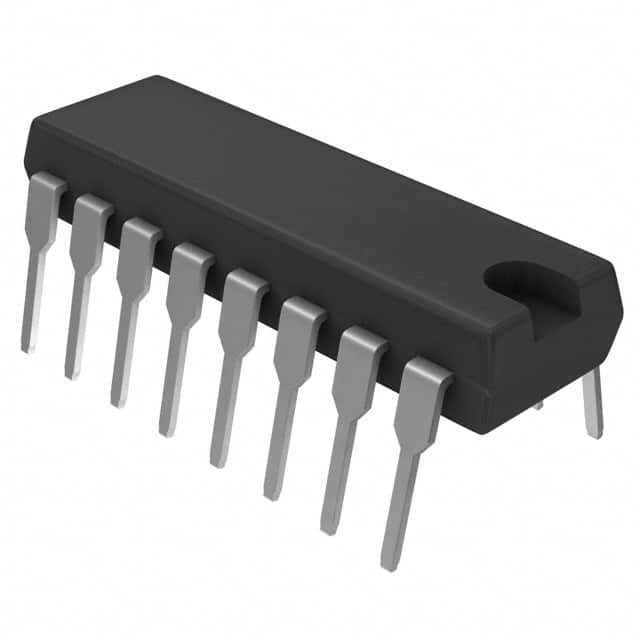Viz Specifikace pro podrobnosti o produktu.

L293B Motor Driver IC
Product Overview
The L293B is a motor driver integrated circuit belonging to the category of semiconductor devices. It is commonly used to control the speed and direction of DC motors, stepper motors, and other similar loads. The L293B is known for its high efficiency, low power consumption, and compact package, making it suitable for various motor control applications. It is available in different packaging options, such as DIP (Dual In-line Package) and SOIC (Small Outline Integrated Circuit), with varying quantities per package.
Specifications
- Supply Voltage: 4.5V to 36V
- Output Current: 600mA per channel (1.2A peak)
- Number of Channels: 4
- Operating Temperature: -20°C to 85°C
- Package Type: DIP, SOIC
Detailed Pin Configuration
The L293B IC has a total of 16 pins, with each pin serving a specific function related to motor control. The pin configuration includes input pins for controlling the motor direction and speed, output pins for connecting to the motor terminals, and additional pins for power supply and ground connections.
Functional Features
- Bidirectional Control: Allows the motor to be driven in both forward and reverse directions.
- Built-in Diodes: Provides protection against back EMF (Electromotive Force) generated by the motor.
- Thermal Shutdown: Prevents damage due to overheating by shutting down the outputs when the temperature exceeds the specified limit.
Advantages and Disadvantages
Advantages
- Versatile: Suitable for a wide range of motor control applications.
- Compact Design: Space-efficient packaging options available.
- Overcurrent Protection: Helps prevent damage to the IC and connected components.
Disadvantages
- Limited Current Capacity: May not be suitable for high-power motor applications.
- Voltage Limitation: Operating voltage range may restrict certain industrial applications.
Working Principles
The L293B operates based on the H-bridge configuration, allowing it to control the polarity and magnitude of the voltage applied to the motor. By appropriately controlling the input signals, the IC can drive the motor in the desired direction and regulate its speed.
Detailed Application Field Plans
The L293B finds extensive use in robotics, automation systems, electronic door locks, and small-scale motion control applications. Its ability to control multiple types of motors makes it a preferred choice in hobbyist projects and educational setups.
Detailed and Complete Alternative Models
- L298N: Offers higher current capacity and additional features for more demanding motor control applications.
- DRV8833: Provides advanced motor control capabilities with integrated current sensing and regulation.
In conclusion, the L293B motor driver IC serves as a reliable and versatile solution for controlling various types of motors in diverse applications. Its compact design, bidirectional control, and built-in protection features make it a popular choice among electronics enthusiasts and professionals alike.
[Word Count: 410]
Seznam 10 běžných otázek a odpovědí souvisejících s aplikací L293B v technických řešeních
What is L293B?
- L293B is a quadruple high-current half-H driver designed to drive inductive loads such as relays, solenoids, DC and bipolar stepping motors.
What is the maximum voltage and current rating of L293B?
- The maximum voltage rating for L293B is 36V, and the maximum continuous current per channel is 600mA.
How many channels does L293B have?
- L293B has four channels, allowing it to control up to four separate loads independently.
Can L293B be used to control both DC and stepper motors?
- Yes, L293B can be used to control both DC motors and bipolar stepper motors.
What are the typical applications of L293B?
- Typical applications of L293B include motor control in robotics, automation, automotive systems, and industrial equipment.
Does L293B require external diodes for inductive load protection?
- Yes, L293B requires external diodes for inductive load protection to prevent damage from back EMF.
What is the logic voltage level required for controlling L293B?
- The logic voltage level required for controlling L293B is 5V.
Can L293B handle PWM signals for speed control of motors?
- Yes, L293B can handle PWM signals for speed control of motors, making it suitable for variable speed applications.
Is there a thermal shutdown feature in L293B?
- Yes, L293B includes a thermal shutdown feature to protect the device from overheating.
What are the key differences between L293D and L293B?
- The main difference is that L293B has an internal clamp diode for inductive load protection, while L293D requires external diodes. Additionally, L293B has a lower output saturation voltage compared to L293D.
Please let me know if you need further assistance with L293B or any other technical queries!

